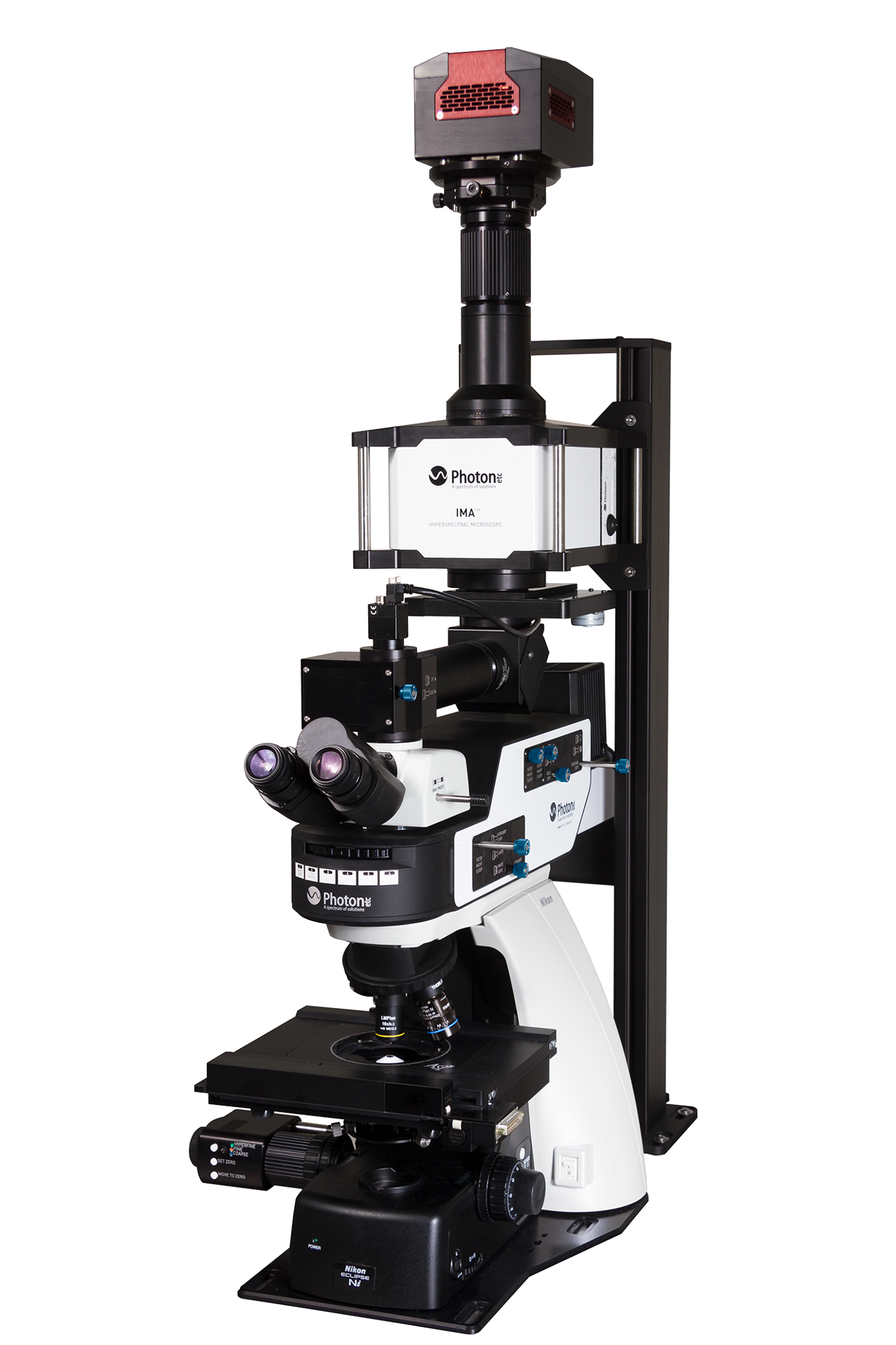In this interview, Marc Verhaegen, CTO of Photon etc., talks to AZoM about the benefits of imaging in the infrared, and their new infrared hyperspectral system for microscopic imaging.
Why did Photon etc. decide to develop a microscopic hyperspectral imaging system for the infrared spectrum?
Most people are already familiar with infrared microscopy just beyond the visible range, where CCD cameras are still sensitive (700-1000nm), but a growing trend in bioimaging and material sciences is to go deeper into the infrared, using InGaAs detectors to cover the range 900-1700nm. Coupled to spectral capabilities, this becomes a unique way to unveil still unknown features of various materials.
Since we had the expertise to put together a system to answer this promising market, offering better performance than existing solutions, we decided to develop an infrared version of IMA™, our fluorescence imaging platform.

IMA™ fluorescence imaging system from Photon etc
What are the main applications of infrared hyperspectral imaging?
Infrared hyperspectral imaging is used in quite a wide range of applications, from agriculture to biomedical imaging, from environmental science to food processing.
Of course, each of these markets and applications has its own requirements, and one instrument cannot cover them all. To decide which way to go, we had to consider both the growth rates of these different markets, and the applications for which our technology would bring the highest return on investment and added value to our customers.
Based on these considerations, we decided to focus on biomedical imaging and advanced material characterization, where our early customers had already confirmed the technological benefits of our imaging systems.
What benefits does infrared imaging offer over the visible range for these application areas?
For researchers using dyes or nanoparticles to study certain properties of cells, proteins or other biological structures, there are two great advantages of working in the infrared - light penetration depth and low background fluorescence.
Firstly, the penetration depth of light in biomaterials can reach several centimetres in the infrared, which allows the internal organs of small animals to be imaged, for example. This is something which is almost impossible with visible light.
Secondly, fluorescent markers are used extensively in biology to observe fundamental mechanisms, but these markers need to be excited by light sources. This produces a significant amount of background fluorescence, or autofluorescence, of the surrounding medium, adding noise to the markers’ signal. The recent development of markers in the infrared opens a new path for low background fluorescence imaging.
For example, CdxPb1−xTe tertiary-alloyed quantum dots emitting in the 1100–1300 nm range have recently been tested with DNA assembly, and exhibit a high signal-to-noise ratio, precisely because of the absence of autofluorescence.
In the case of emerging materials like new photovoltaic solar cells or various semiconductors, the nature of the bandgap of the material dictates the use of characterization in the infrared. For example, the bandgap of cadmium-indium-gallium-arsenide (CIGS), a material used extensively to produce solar cells, is around 1200nm. Thus, imaging in the infrared allows homogeneity maps, obviously quite useful when developing the next generation of photovoltaic devices.
How does your hyperspectral imaging system differ from other microscopy systems?
Firstly, Photon etc. is the only company manufacturing hyperspectral imaging systems based on our patented Bragg tunable filter. Unlike spectrometer based systems, this technology allows us to do global imaging (i.e. taking complete megapixel filtered images, one wavelength at a time). When combined with the high efficiency of the gratings and the fact that they are almost polarization independent, the overall throughput of the instrument is very high and directly translates into a great gain in measurement speed.
With such a fast acquisition time, data cubes taking hours to acquire with other point-by-point mapping systems are now possible in minutes.
Photon etc - IMA Hyperspectral Microscope
What software packages do you provide to control these systems and analyze the data?
PHySpec™, our proprietary software, is designed to both control the hardware of our imaging platforms and to process the data produced through a wide range of analytical tools. This software provides standard analytical tools that are generally used in spectroscopy and imaging.
In addition, we also wanted to improve the flexibility of our system by allowing simple programming of automatic sequences. Like any other similar system, our software allows the experimental parameters to be adjusted, but we also added the possibility to program sequences of acquisition through simple functions within the software, something our clients unanimously appreciate.
Furthermore, unlike other manufacturers, we offer our clients as many software licences as needed, at no extra cost. For us, this always seemed natural, since scientists will rarely analyse their data with the computer used to control their system.
Are there any other developments in infrared imaging that Photon etc. has been working on?
Technical innovations based on customers’ needs is the essence of our company - infrared systems represent an important part of R&D activities, so there have been a number of projects involving development of infrared imaging technology.
One of our first and most important developments in this regard was a new and unique line of Mercury Cadmium Telluride (MCT) 2D imaging sensors, which is now successfully deployed for waste material sorting. This was in response to a request from an industrial customer, but it became the basis from which other developments emerged.
One of the recent projects that came from this was a hyperspectral imaging system for tracking infrared markers in small animals. This promising instrument is now being tested in one of the largest cancer research facilities in North America.

Zephir SWIR Camera from Photon etc
In parallel to infrared systems, we continue the evolution of our fluorescence and Raman imaging platforms in the visible and near infrared. Finally, our laser line filter technology has been optimized to be compatible with ultra-high power (>10W) supercontinuum sources.
Is your technology focused purely on research applications and the academic market?
Some of our closest collaborators are indeed from academia, but as our technology evolves, we are seizing every opportunity to extend our activities into industrial applications.
Our infrared cameras are used for industrial sorting, our imaging platforms are now helping with the discovery of new drugs, and we are developing carbon nanotube based Raman tracers with applications in medical diagnostics and anti-counterfeiting.
Since innovation is very important for us, we also encourage the creation of spin-offs when the technology we produce is outside of our traditional expertise and markets. In recent years, three companies were born out of this process - Photonic Knowledge in the mining industry, Optina Diagnostics in retinal imaging, and NüVü Cameras manufacturing high-end scientific cameras.
Can you provide some background on Photon etc and your wider range of analysis products?
Our core technology was first developed as an answer to astronomical instrumentation problems, but after ten successful years, our current mission is to help researchers and manufacturers achieve their goals with state-of-the-art imaging solutions.
From solar cells to live cells, our fast and integrated hyperspectral imaging systems provide access to the latest innovation in optical instrumentation.
Where can we find further information on your technology?
Our website offers quite a lot of information on our technology and products, but you can also contact us directly for more information on [email protected]. We are always happy to discuss our technology, and even happier to learn about new applications we might never have thought of!
About Marc Verhaegen
Marc Verhaegen has been in charge of research and development at Photon etc for the past 9 years. He has over 20 years of experience in photonics R&D. Marc Verhaegen obtained his Master's degree in optoelectronics from the Université de Liège in Belgium, and his Ph.D in Physics from the Université de Montréal.
Author of many publications, he completed his postdoctoral studies in the fibre-optics laboratory at École Polytechnique de Montréal, working specifically on the intensification of second order non-linear effects for fibre-optics and silica glass.
Marc Verhaegen is an expert in the manufacture of high-performance devices based on Bragg gratings. He has worked as a researcher and a technical leader in the R&D departments of companies including ITF Optical Technologies and Corvis Canada.
Disclaimer: The views expressed here are those of the interviewee and do not necessarily represent the views of AZoM.com Limited (T/A) AZoNetwork, the owner and operator of this website. This disclaimer forms part of the Terms and Conditions of use of this website.